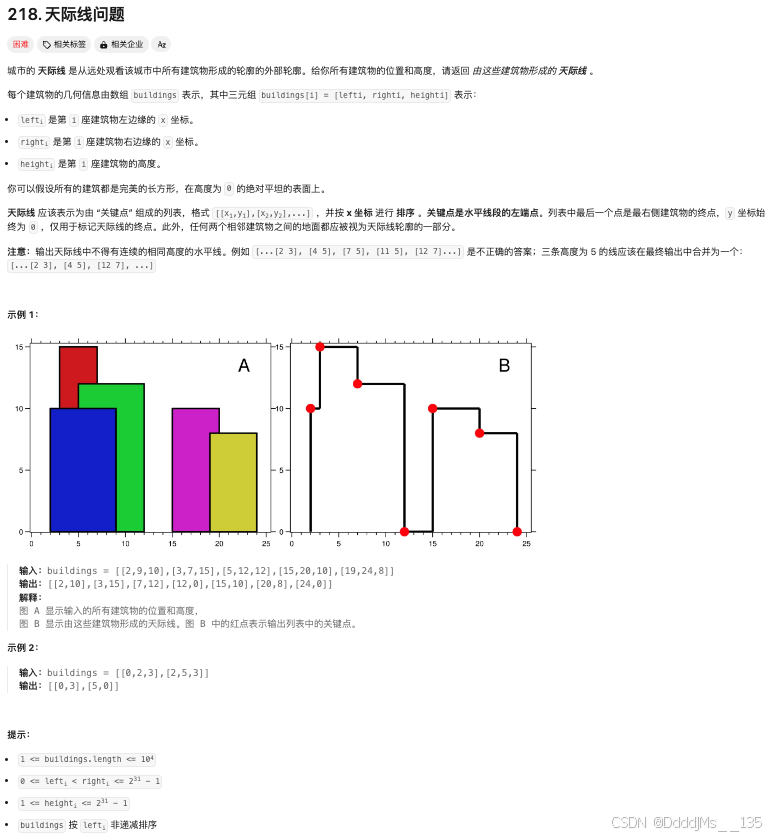C语言 | Leetcode C语言题解之第218题天际线问题
题目:

题解:
struct pair {
int first, second;
};
struct Heap {
struct pair* heap;
int heapSize;
bool (*cmp)(struct pair*, struct pair*);
};
void init(struct Heap* obj, int n, bool (*cmp)(struct pair*, struct pair*)) {
obj->heap = malloc(sizeof(struct pair) * (n + 1));
obj->heapSize = 0;
obj->cmp = cmp;
}
bool cmp1(struct pair* a, struct pair* b) {
return a->second < b->second;
}
void swap(struct pair* a, struct pair* b) {
struct pair tmp = *a;
*a = *b, *b = tmp;
}
void push(struct Heap* obj, int x, int y) {
int p = ++(obj->heapSize), q = p >> 1;
obj->heap[p] = (struct pair){x, y};
while (q) {
if (!obj->cmp(&(obj->heap[q]), &(obj->heap[p]))) {
break;
}
swap(&(obj->heap[q]), &(obj->heap[p]));
p = q, q = p >> 1;
}
}
void pop(struct Heap* obj) {
swap(&(obj->heap[1]), &(obj->heap[(obj->heapSize)--]));
int p = 1, q = p << 1;
while (q <= obj->heapSize) {
if (q + 1 <= obj->heapSize) {
if (obj->cmp(&(obj->heap[q]), &(obj->heap[q + 1]))) {
q++;
}
}
if (!obj->cmp(&(obj->heap[p]), &(obj->heap[q]))) {
break;
}
swap(&(obj->heap[q]), &(obj->heap[p]));
p = q, q = p << 1;
}
}
struct pair top(struct Heap* obj) {
return obj->heap[1];
}
bool empty(struct Heap* obj) {
return obj->heapSize == 0;
}
int cmp(int* a, int* b) {
return *a - *b;
}
int** getSkyline(int** buildings, int buildingsSize, int* buildingsColSize, int* returnSize, int** returnColumnSizes) {
int n = buildingsSize;
struct Heap* heap = malloc(sizeof(struct Heap));
init(heap, n << 1, cmp1);
int boundaries[n << 1];
for (int i = 0; i < n; i++) {
boundaries[i << 1] = buildings[i][0];
boundaries[i << 1 | 1] = buildings[i][1];
}
qsort(boundaries, n << 1, sizeof(int), cmp);
int** ret = malloc(sizeof(int*) * (n << 1));
*returnColumnSizes = malloc(sizeof(int) * (n << 1));
*returnSize = 0;
int idx = 0;
for (int i = 0; i < (n << 1); i++) {
int boundary = boundaries[i];
while (idx < n && buildings[idx][0] <= boundary) {
push(heap, buildings[idx][1], buildings[idx][2]);
idx++;
}
while (!empty(heap) && top(heap).first <= boundary) {
pop(heap);
}
int maxn = empty(heap) ? 0 : top(heap).second;
if ((*returnSize) == 0 || maxn != ret[(*returnSize) - 1][1]) {
int* tmp = malloc(sizeof(int) * 2);
tmp[0] = boundary, tmp[1] = maxn;
(*returnColumnSizes)[*returnSize] = 2;
ret[(*returnSize)++] = tmp;
}
}
return ret;
}原文地址:https://blog.csdn.net/m0_59237910/article/details/140223098
免责声明:本站文章内容转载自网络资源,如本站内容侵犯了原著者的合法权益,可联系本站删除。更多内容请关注自学内容网(zxcms.com)!
